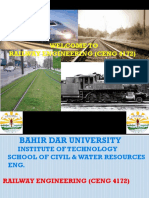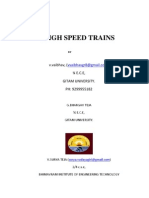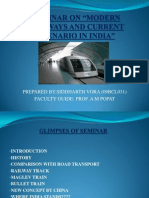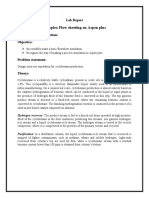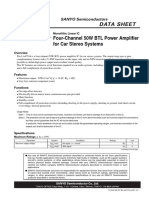0 ratings0% found this document useful (0 votes)
69 viewsRailway (Lecture-1)
This document provides an overview of transportation engineering and railways. It discusses the main domains of transportation engineering including highway, waterway, air, pipeline, and space. The objective of transportation engineering is ensuring safe, rapid, comfortable, convenient, economical, and environmentally compatible movement of people and goods. The document then discusses the importance of transportation engineering within civil engineering and provides a brief history of the development of railways.
Uploaded by
OBIDUR RAHMAN 1701085Copyright
© © All Rights Reserved
Available Formats
Download as PDF, TXT or read online on Scribd
0 ratings0% found this document useful (0 votes)
69 viewsRailway (Lecture-1)
This document provides an overview of transportation engineering and railways. It discusses the main domains of transportation engineering including highway, waterway, air, pipeline, and space. The objective of transportation engineering is ensuring safe, rapid, comfortable, convenient, economical, and environmentally compatible movement of people and goods. The document then discusses the importance of transportation engineering within civil engineering and provides a brief history of the development of railways.
Uploaded by
OBIDUR RAHMAN 1701085Copyright
© © All Rights Reserved
Available Formats
Download as PDF, TXT or read online on Scribd
You are on page 1/ 14
TRANSPORTATION ENGINEERING-I :
(CE-341)
Lecture: 01
Prof. Dr. Mahmood Omar Imam
Department of Civil Engineering, CUET
momarimam@cuet.ac.bd
Transportation Engineering
Main domains: Highway Tasks of a Transport Engineer:
– Railway - Planning
– Waterway - Functional design
– Air - Operation and
– Pipeline - Management of facilities
– Space
Objective of Transportation Engineering:
Ensuring Safe, rapid, comfortable, convenient, economical, and
environmentally compatible movement of people and goods.
Prof. Mahmood Omar Imam
Importance
Importance of transportation engineering
within the civil engineering profession
– Can be judged by the number of divisions in ASCE
(American Society of Civil Engineers) that are directly
related to transportation
• Six divisions (Aerospace; Air Transportation;
Highway; Pipeline; Waterway, Port, Coastal and
Ocean; and Urban Transportation)
• Represents one-third of the total 18 technical
divisions within the ASCE (2000)
Prof. Mahmood Omar Imam
Introduction to CE-341
4 credits
Course outline
– Transportation planning
– Highway elements
– Traffic engineering
– Railways
Traditionally regarded as the most dreaded course of CE
undergraduate curriculum !
– Deathtrap: Railways !
• Memorization
• English skills
Prof. Mahmood Omar Imam
Introduction to Railways
Outline of lectures on railway
– General requirements
– Geometric Design & Alignment
– Permanent way
– Station and yards
– Signaling
– Points and crossings
– Maintenance
Key to success
– Do not pile up work
Prof. Mahmood Omar Imam
Resources
Suggested Readings
– Principles of Railway Engineering: Rangawala (2000)
– Railway Engineering: Agarwal and Chandra, Oxford
University Press (1997)
Bangladesh Railway Information Book –
http://www.railway.gov.bd
-> Important Information
Prof. Mahmood Omar Imam
History of Railroads: Timeline
Manual/ horse drawn railways
– 1550: Hand propelled tubs known as "hunds“ in Germany
– 1603/4: first recorded above ground early railway/ wagonway
– 1798: Lake Lock Railroad, the world's first public railway (carried only coal)
– 1803: The first public passenger railway, the Surrey Iron Railway opens in
south London.
Steam Engines
– 1804: First steam locomotive railway - Penydarren - built by Trevithick,
used to haul iron in Wales
– 1814: George Stephenson constructs his first locomotive, Blücher
– 27th September 1825: The first public railway was opened for traffic in
England of about speed 19.32 km/hr.
– 1829: George and Robert Stephenson's locomotive, The Rocket, sets a
speed record of 47 km/h (29 mph), Liverpool
– 1857: First steel rails used in Britain
– 1863: First underground railway, the 4 mile (6.2 km) Metropolitan Railway
opened in London. It was powered by adapted steam engines
Prof. Mahmood Omar Imam
History of Railroads: Timeline
St. Catharine’s Street Railway, Canada 1833-34 : Built by Cherepanov and his son,
total distance of about 3.2 Km (two miles)
Rails in Indian Subcontinent
– 1851: First train in British India, built by British invention and
administration
– 1853: Passenger train makes in début in Bombay, India –1901:
trains in our territories
Prof. Mahmood Omar Imam
History of Railroads: Timeline
Electricity propelled
– 1879 First electric railway demonstrated at the Berlin Trades
Fair
– 1890 First electric London Underground railway (subway)
opened in London—all other subway systems soon followed
suit Diesel locomotives
– 1913 First diesel powered railcar enters service in Sweden
Diesel Electric locomotive
– 1924 First diesel-electric locomotive built in Soviet Union
(USSR)
– Dominant type of locomotive in the world today
Prof. Mahmood Omar Imam
The Quest for Speed
• 1957 Japan sets narrow gauge world speed record of 145 km/h (90 mph)
with Odakyū 3000 series SE Romancecar .
• 1964 Bullet Train service introduced in Japan, between Tokyo and Osaka.
Trains average speeds of 160 km/h (100 mph) due to congested shared
urban tracks, with top speeds of 210 km/h
• 2003 Heavily modified trainset of France's TGV had beaten its original
world record when it travelled 320 km/h
TGV at Paris Station
Prof. Mahmood Omar Imam
The Quest for Speed
The Shanghai Maglev Train or Shanghai Transrapid being the first commercial high-speed
maglev line in the world —the top operational commercial speed of this train is 431 km/h
(268mph), making it the world's fastest train in regular commercial services since its
opening in 2004.
Magnetic Levitation (Maglev) Principle
Opposite poles on magnets keep train above track
Train is propelled by electro-magnetic system in the
sides of the "guideway" instead of onboard engine
Trains “float” over a guideway without any contact
between train and rail resulting “zero” frictional loss
Prof. Mahmood Omar Imam
Comparison with Roadway
Load handling capacity
– Railway can handle heavier loads at higher speeds
Construction, maintenance and operating cost
– Railway has higher construction and maintenance cost but lower
operations cost
Speed
– High speed rails are much faster than roadway
Degree of freedom
– Railway movements are restricted to be in one direction
Length of haul (Distance)
– Railways are much more convenient for long haul (>500km trips)
Topography
– Railway less suitable in hilly terrains with curves
Prof. Mahmood Omar Imam
Comparison with Roadway
Energy consumption
– Energy required in railway per ton is less than roadway – Is very
environment friendly if ‘clean’ electricity is used
Operational Controls
– Essential in the form of signaling & Interlocking for movement of rail way
Use
Suitable for specific service only i.e. BG, MG & NG
Right of way
Less width for right of way required for railway
Right of entry
– Railway has not free right to ingress and egress
Tractive resistance
– Railway have five to six time less of road
Accident rate
– Railway have few but the fatale rate is higher
Prof. Mahmood Omar Imam
Comparison with Roadway
Advantages
High capacity
Lower operating cost
High speed
Fixed route and easier operation
Prof. Mahmood Omar Imam
You might also like
- Field Study Report On "Marketing Strategy On Honda Automobile"100% (1)Field Study Report On "Marketing Strategy On Honda Automobile"49 pages
- Decision Makers' Guide to Road Tolling in CAREC CountriesFrom EverandDecision Makers' Guide to Road Tolling in CAREC CountriesNo ratings yet
- One Introduction To Railway EngineeringNo ratings yetOne Introduction To Railway Engineering31 pages
- Lecturenote - 208064694chapter-1 Basics of RailwayNo ratings yetLecturenote - 208064694chapter-1 Basics of Railway75 pages
- Railway Engineering - AccessScience From McGraw-Hill EducationNo ratings yetRailway Engineering - AccessScience From McGraw-Hill Education13 pages
- Comparative Between Electric Traction and Fuel Cell LocomotivesNo ratings yetComparative Between Electric Traction and Fuel Cell Locomotives3 pages
- Railway and Tunnel Construction Teaching ModuleNo ratings yetRailway and Tunnel Construction Teaching Module63 pages
- Elearning-Chapter 5-Carriage of Goods by Rail ModeNo ratings yetElearning-Chapter 5-Carriage of Goods by Rail Mode95 pages
- Introduction 2018 Principles of Railway Location and DesignNo ratings yetIntroduction 2018 Principles of Railway Location and Design8 pages
- Railway Engineering (CL-410) : 1 ReferenceNo ratings yetRailway Engineering (CL-410) : 1 Reference49 pages
- Modernization of railways and high-speed railsNo ratings yetModernization of railways and high-speed rails37 pages
- RMC-142D, Installation Instructions 4189340158 UKNo ratings yetRMC-142D, Installation Instructions 4189340158 UK4 pages
- Information Memorandum - Suman Sarwari ProjectNo ratings yetInformation Memorandum - Suman Sarwari Project18 pages
- Shell Rimula R4 L 15W-40: Performance, Features & Benefits Specifications, Approvals & RecommendationsNo ratings yetShell Rimula R4 L 15W-40: Performance, Features & Benefits Specifications, Approvals & Recommendations2 pages
- Physics Challenge For Teachers and Students: Solutions To January 2007 ChallengeNo ratings yetPhysics Challenge For Teachers and Students: Solutions To January 2007 Challenge2 pages
- Planos Electricos Invertex 2 Serie 31875 UpNo ratings yetPlanos Electricos Invertex 2 Serie 31875 Up23 pages
- CLASS XII (2018-19) Theory: Unit No. Title No. of Periods MarksNo ratings yetCLASS XII (2018-19) Theory: Unit No. Title No. of Periods Marks4 pages
- Plexiglas General Information and Physical PropertiesNo ratings yetPlexiglas General Information and Physical Properties24 pages
- COMS PUB 0021 - A Roadmap For Indonesia - S Power SectorNo ratings yetCOMS PUB 0021 - A Roadmap For Indonesia - S Power Sector64 pages
- Chapter 8 - Mechanical Properties of Metals - Week 6&7100% (1)Chapter 8 - Mechanical Properties of Metals - Week 6&740 pages
- Syllabus: Cambridge O Level Combined ScienceNo ratings yetSyllabus: Cambridge O Level Combined Science48 pages
- Simple Secrets To Totally Rocking Your Handyman ServicesNo ratings yetSimple Secrets To Totally Rocking Your Handyman Services3 pages
- Field Study Report On "Marketing Strategy On Honda Automobile"Field Study Report On "Marketing Strategy On Honda Automobile"
- Railroad Accidents Their Cause and PreventionFrom EverandRailroad Accidents Their Cause and Prevention
- Decision Makers' Guide to Road Tolling in CAREC CountriesFrom EverandDecision Makers' Guide to Road Tolling in CAREC Countries
- Lecturenote - 208064694chapter-1 Basics of RailwayLecturenote - 208064694chapter-1 Basics of Railway
- Railway Engineering - AccessScience From McGraw-Hill EducationRailway Engineering - AccessScience From McGraw-Hill Education
- Comparative Between Electric Traction and Fuel Cell LocomotivesComparative Between Electric Traction and Fuel Cell Locomotives
- Elearning-Chapter 5-Carriage of Goods by Rail ModeElearning-Chapter 5-Carriage of Goods by Rail Mode
- Introduction 2018 Principles of Railway Location and DesignIntroduction 2018 Principles of Railway Location and Design
- Shell Rimula R4 L 15W-40: Performance, Features & Benefits Specifications, Approvals & RecommendationsShell Rimula R4 L 15W-40: Performance, Features & Benefits Specifications, Approvals & Recommendations
- Physics Challenge For Teachers and Students: Solutions To January 2007 ChallengePhysics Challenge For Teachers and Students: Solutions To January 2007 Challenge
- CLASS XII (2018-19) Theory: Unit No. Title No. of Periods MarksCLASS XII (2018-19) Theory: Unit No. Title No. of Periods Marks
- Plexiglas General Information and Physical PropertiesPlexiglas General Information and Physical Properties
- COMS PUB 0021 - A Roadmap For Indonesia - S Power SectorCOMS PUB 0021 - A Roadmap For Indonesia - S Power Sector
- Chapter 8 - Mechanical Properties of Metals - Week 6&7Chapter 8 - Mechanical Properties of Metals - Week 6&7
- Simple Secrets To Totally Rocking Your Handyman ServicesSimple Secrets To Totally Rocking Your Handyman Services



